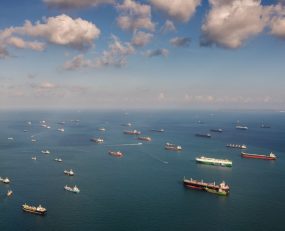
There are tentative signs that the intercontinental freight market is beginning to turn, possibly quite sharply.
The most recent evidence is from Cathay Pacific Cargo, which is reported to be briefing clients that this year’s peak season will not be as strong as usual. Admittedly this is heavily influenced by economic conditions in both China and Hong Kong, but it fits the mood music in much of the rest of the world.
Marine container freight spot rates on the trans-Pacific route have been falling for some time, although container shipping line results continue to reflect the strength of the contract-rate market segment. Crucially there are signs that congestion in container ports is improving rapidly. For example, at the once-troubled port of Los Angeles, the senior management claims that there has been a fall in the “backlog of ships almost 90%”. The port has again postponed the implementation of a ‘dwell fee’ on containers at terminals due to a “combined decline of 46% in ageing cargo on the docks”. The situation on East Coast container terminals appears to be improving similarly, and there are reports from European ports on the Hamburg-Le Havre range that congestion has also improved.
The potential of this decline in congestion to release shipping capacity onto the market is considerable, and it may already be playing a role in driving-down spot rates. If congestion continues to improve, it might dramatically affect rates, with the ‘blanking’ activity of container lines suggesting they are already aware of this.
As with the boom in demand seen in 2020-2021, much of the force behind these developments is associated with consumer behaviour in the US. Admittedly the port of Los Angeles continues to see higher container through-put; however, shippers’ inventory management operations are more under control, enabling container, demurrage and warehousing systems to right themselves. As a result, major retailers have pursued significant inventory sell-offs and are cautious in their buying behaviour, moving towards Christmas in the face of what looks like a recession. Obviously, this is informed both by energy price increases and higher inflation.
None of these factors on their own, either an operational improvement, muted US economic signals or continued instability in China, will drive falling rates, but they suggest a marked changed environment for logistics markets.
Download Ti’s Global Ocean Freight Rates Tracker for Q3 2022 for an in-depth look at the key data driving rate development in global ocean freight, covering major transpacific, transatlantic and Asia-Europe lanes.
Source: Transport Intelligence, 1st September 2022
Author: Thomas Cullen